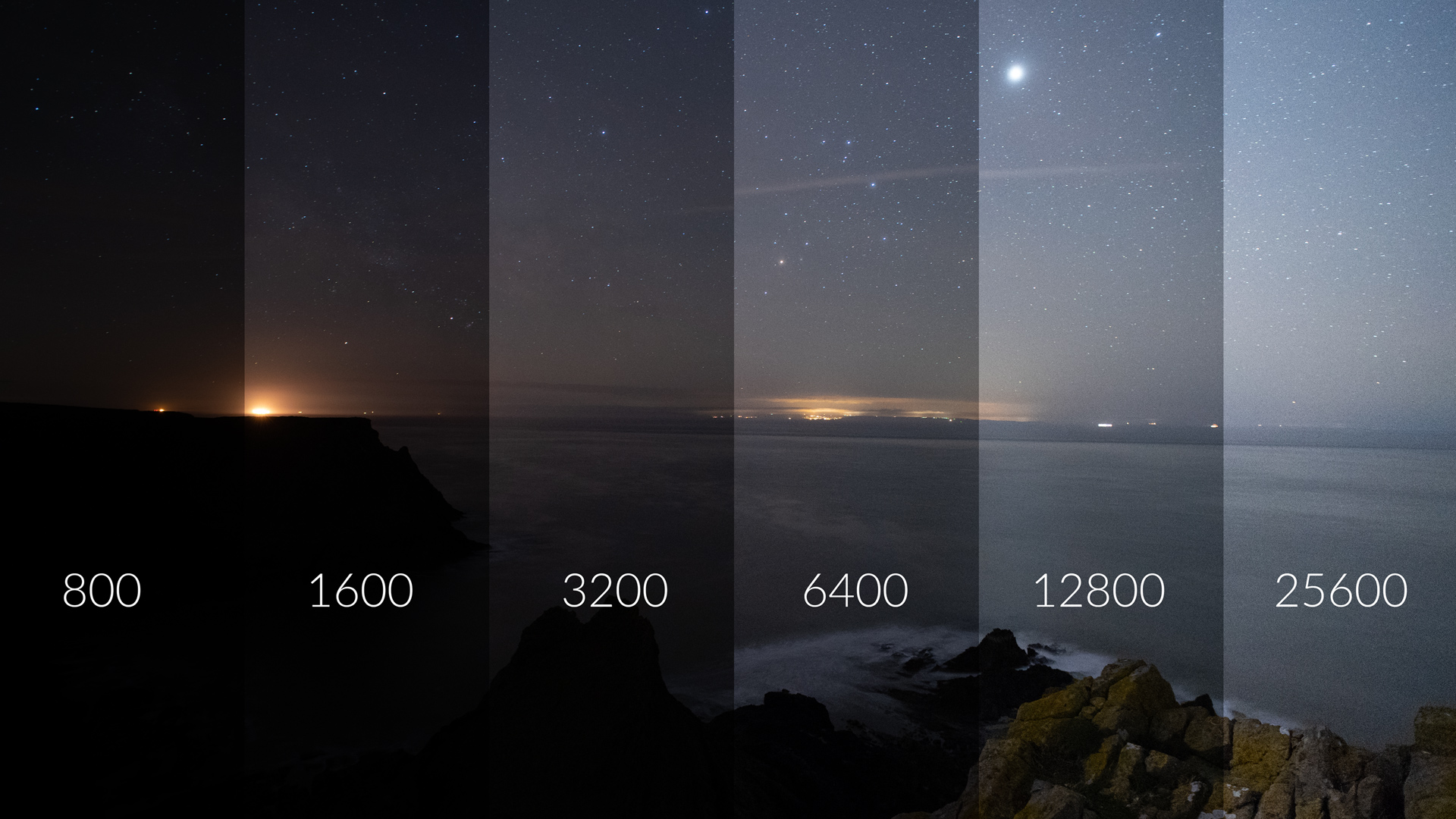Testing the Sony A7iii for ISO invariance
This article serves as extra information for my Sony A7III Astro Review Video regarding its ISO-invariant performance:
As a landscape astrophotographer one of the first things I'll do when using a new camera is to find out the best ISO to use for low-light noise performance. The way to do this is to test the camera at all its ISO settings and find the point at which it begins to display ISO-invariant behaviour (if it even does at all).
Before I get into the testing it's worth understanding what the ISO does in digital photography and what exactly is ISO-variant and ISO-invariant behaviour. For this, you'll need to know a bit more about the stages of the image capturing process.
Light is emitted from the scene as photons which pass through the lens and onto your camera's sensor.
The sensor 'converts' those photons into electrons which collect in the pixel that they landed on (think of the pixels as buckets collecting electrons).
When the exposure is finished, the total amount of electrons collected in each pixel makes up the output signal which goes on to be boosted by an analogue amplifier at a factor directly related to the ISO setting of the camera. The higher the ISO, the more the sensor output signal is boosted and thus the brighter the final image. Although different makes and models of cameras vary, we can roughly say that doubling the ISO will double the amount of analogue amplification and thus, increase the image brightness by a factor of two.
The boosted signal is then converted from analogue to digital (ie. from a voltage to a numerical value)
CPU within the camera writes the final image to the memory card.
Throughout the image capturing process there are many sources of noise that find their way into the image. Firstly, the light emitted from the scene is done so at a non-consistent rate. This is known as photon noise or shot noise, however, for the purposes of investigating ISO-invariance we can consider it negligible.
The other category is read noise, noise that is incurred due to imperfections of the camera's electronics. Read noise can be split into two categories; upstream read noise and downstream read noise.
Upstream read noise is any noise that is induced before or during the analogue amplification process (ie. the moment that the sensor output signal is boosted at a gain related to your ISO setting). For example, a lot of noise can be traced back to the sensor heating up during a long exposure, or there may be imperfections in resetting the electrons in the pixel wells before the start of the next exposure.
Downstream read noise is any noise that is induced after the analogue amplification process. This includes imperfections in the analogue-to-digital converter for example.
As upstream read noise is induced before the analogue amplification stage, you can see that if you are using a high ISO it is also boosted along with the signal recorded from the scene. Any downstream read noise remains constant, as it is not affected by the analogue amplification process and thus, not affected by your ISO setting.
So what does this mean? Well, if a camera has little to no downstream read noise it is said to be ISO-invariant. In other words, if your camera is ISO-invariant it will show the same amount of visible noise in the image whether you increase the ISO in camera or boost the exposure value in post-production.
The Sony A7iii is an ISO-invariant camera in two stages. From ISO100-500 and then from ISO640-51200. The images below were all taken at f/2.8 with a shutter speed of 20 secs but at varying ISO values.
Then if we balance the exposure values in post-production we can see that each image has the same amount of noise:
So boosting the exposure in post is the same as increasing the ISO in camera, due to the lack of downstream read noise.
Now one more thing you need to know is that increasing the ISO will decrease the amount of dynamic range you can capture (as you are raising 'the floor' of the pixel wells). This is not something I'm going to go into in detail right now but you can see this clearly in the photonstophotos.net graph of dynamic range vs. ISO.
Technically the best ISO to use on the Sony A7iii is ISO 640. At this point you get no improvement in noise performance if you boost the ISO any further and you will be using the setting with the highest dynamic range possible. You can then boost the exposure in post-production if need be.
There's one problem though and that is the impracticality of using ISO640 in the field... you won't be able to preview your composition as the images will be too dark! For this reason, I still find myself shooting at ISO 3200 and ISO 6400 (but I'm always careful to make sure I'm not blowing any highlights). Although the dynamic range of the images isn't as high, I can at least preview my compositions in the field which to me is worth the sacrifice of a little dynamic range.
However, there are a number of benefits of being able to shoot at ISO 640 and boost in post. For example, as I mentioned in my YouTube review, when shooting timelapses of the aurora you decrease the risk of the highlights blowing should be the aurora suddenly begin to brighten. If it doesn’t brighen, you can boost the exposure in post with no worries.
Also, when shooting moonscapes you can protect the highlights by using a lower ISO, but still have the ability to pull good detail out of the shadow areas as if you were using a higher ISO.
Before picking up the Sony A7iii I mainly shot on the Canon 6D which is an ISO-variant camera, however, it begins to show ISO-invariant behaviour from ISO 6400 and upwards. For the most part, I found myself shooting at ISO 6400 on the 6D in order to achieve the best low-light noise performance so I am now quite enjoying the freedom and benefits of using an ISO-invariant sensor in the Sony A7iii.
All in all, I am really enjoying shooting on the Sony A7III. The high dynamic range means I can pull amazing detail out of the shadows with no discolouration and I am really enjoying the benefits of an ISO-invariant sensor.
Buy Sony A7iii - https://goo.gl/iGG8Wx
Neewer Wired Intervalometer - https://goo.gl/ZVoYzM
Pixel Wireless Intervalometer - https://goo.gl/pk67P2
Sony NP-FZ100 Z Battery - https://goo.gl/opWpKP



